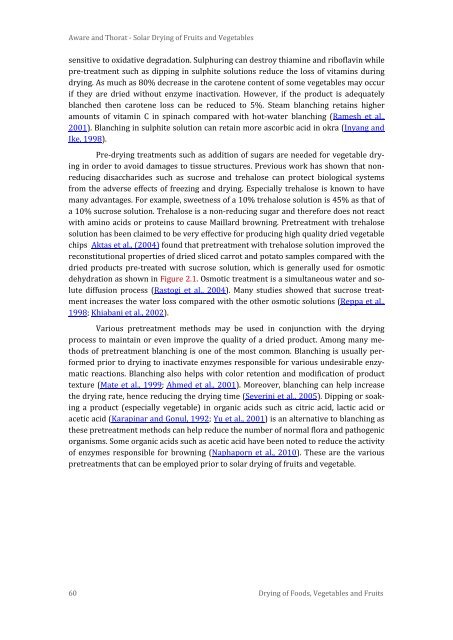Solar Drying: Fundamentals,Applications and Innovations - National ...
Solar Drying: Fundamentals,Applications and Innovations - National ...
Solar Drying: Fundamentals,Applications and Innovations - National ...
Create successful ePaper yourself
Turn your PDF publications into a flip-book with our unique Google optimized e-Paper software.
Aware <strong>and</strong> Thorat - <strong>Solar</strong> <strong>Drying</strong> of Fruits <strong>and</strong> Vegetables<br />
sensitive to oxidative degradation. Sulphuring can destroy thiamine <strong>and</strong> riboflavin while<br />
pre-treatment such as dipping in sulphite solutions reduce the loss of vitamins during<br />
drying. As much as 80% decrease in the carotene content of some vegetables may occur<br />
if they are dried without enzyme inactivation. However, if the product is adequately<br />
blanched then carotene loss can be reduced to 5%. Steam blanching retains higher<br />
amounts of vitamin C in spinach compared with hot-water blanching (Ramesh et al.,<br />
2001). Blanching in sulphite solution can retain more ascorbic acid in okra (Inyang <strong>and</strong><br />
Ike, 1998).<br />
Pre-drying treatments such as addition of sugars are needed for vegetable drying<br />
in order to avoid damages to tissue structures. Previous work has shown that nonreducing<br />
disaccharides such as sucrose <strong>and</strong> trehalose can protect biological systems<br />
from the adverse effects of freezing <strong>and</strong> drying. Especially trehalose is known to have<br />
many advantages. For example, sweetness of a 10% trehalose solution is 45% as that of<br />
a 10% sucrose solution. Trehalose is a non-reducing sugar <strong>and</strong> therefore does not react<br />
with amino acids or proteins to cause Maillard browning. Pretreatment with trehalose<br />
solution has been claimed to be very effective for producing high quality dried vegetable<br />
chips Aktas et al., (2004) found that pretreatment with trehalose solution improved the<br />
reconstitutional properties of dried sliced carrot <strong>and</strong> potato samples compared with the<br />
dried products pre-treated with sucrose solution, which is generally used for osmotic<br />
dehydration as shown in Figure 2.1. Osmotic treatment is a simultaneous water <strong>and</strong> solute<br />
diffusion process (Rastogi et al., 2004). Many studies showed that sucrose treatment<br />
increases the water loss compared with the other osmotic solutions (Reppa et al.,<br />
1998; Khiabani et al., 2002).<br />
Various pretreatment methods may be used in conjunction with the drying<br />
process to maintain or even improve the quality of a dried product. Among many methods<br />
of pretreatment blanching is one of the most common. Blanching is usually performed<br />
prior to drying to inactivate enzymes responsible for various undesirable enzymatic<br />
reactions. Blanching also helps with color retention <strong>and</strong> modification of product<br />
texture (Mate et al., 1999; Ahmed et al., 2001). Moreover, blanching can help increase<br />
the drying rate, hence reducing the drying time (Severini et al., 2005). Dipping or soaking<br />
a product (especially vegetable) in organic acids such as citric acid, lactic acid or<br />
acetic acid (Karapinar <strong>and</strong> Gonul, 1992; Yu et al., 2001) is an alternative to blanching as<br />
these pretreatment methods can help reduce the number of normal flora <strong>and</strong> pathogenic<br />
organisms. Some organic acids such as acetic acid have been noted to reduce the activity<br />
of enzymes responsible for browning (Naphaporn et al., 2010). These are the various<br />
pretreatments that can be employed prior to solar drying of fruits <strong>and</strong> vegetable.<br />
60 <strong>Drying</strong> of Foods, Vegetables <strong>and</strong> Fruits

















